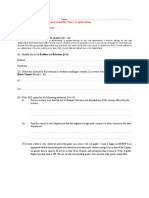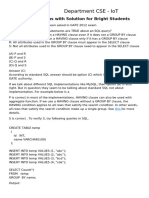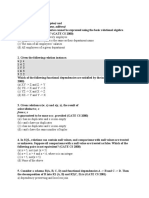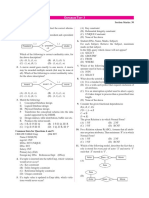0 ratings0% found this document useful (0 votes)
40 viewsTutorial 5
This document contains 5 questions regarding relational algebra queries on various database schemas. Question 1 asks how many tuples would be returned by a given query on relations P, Q, and R. Question 2 describes the natural outer join of two relations and asks which tuples would be contained in the resulting relation. Question 3 asks for a query to return employee IDs of employees older than all their dependents. Question 4 provides a database schema and asks for queries related to flights and bookings. Question 5 asks to optimize a given relational algebra expression.
Uploaded by
rnbapatCopyright
© © All Rights Reserved
Available Formats
Download as PDF, TXT or read online on Scribd
0 ratings0% found this document useful (0 votes)
40 viewsTutorial 5
This document contains 5 questions regarding relational algebra queries on various database schemas. Question 1 asks how many tuples would be returned by a given query on relations P, Q, and R. Question 2 describes the natural outer join of two relations and asks which tuples would be contained in the resulting relation. Question 3 asks for a query to return employee IDs of employees older than all their dependents. Question 4 provides a database schema and asks for queries related to flights and bookings. Question 5 asks to optimize a given relational algebra expression.
Uploaded by
rnbapatCopyright
© © All Rights Reserved
Available Formats
Download as PDF, TXT or read online on Scribd
You are on page 1/ 2
Tutorial 5
CSN-351/AID-523 Database Management Systems
1. Consider the following relations P(X,Y,Z) ; Q(X,Y,T) and R(V,Y)
How many tuples will be returned by the following relational
algebra query?
2. Consider two relations R1(A, B) with the tuples (1, 5), (3, 7) and
R1(A, C) = (1, 7), (4, 9). Assume that R(A,B,C) is the full natural
outer join of R1 and R2. Consider the following tuples of the
form (A,B,C)
a = (1, 5, null); b = (1, null, 7) ; c = (3, null, 9) ; d = (4, 7,
null); e = (1, 5, 7) ; f = (3, 7, null) ; g = (4, null, 9).
Which one of the following statements is correct?
(A) R contains a, b, e, f, g but not c, d
(B) R contains a, b, c, d, e, f, g
(C) R contains e, f, g but not a, b
(D) R contains e but not f, g
3. Consider the relational schema given below, where eId of the
relation Dependent is a foreign key referring to empId of the
relation Employee. Assume that every employee has at least
one associated dependent in the Dependent relation.
Employee (empId, empName, empAge)
Dependent (depId, eId, depName, depAge)
Write a relational algebra query which returns the set of
empIds of employees whose age is greater than that of all of
his/her dependents.
4. Consider the following relational database schema consisting of
the four relation schemas:
passenger ( pid, pname, pgender, pcity)
agency ( aid, aname, acity)
flight (fid, fdate, time, src, dest)
booking (pid, aid, fid, fdate)
Answer the following questions using relational algebra queries;
a. Get the details of flights that are scheduled on either of
the dates 01/12/2020 or 02/12/2020 or both at 16:00
hours.
b. Find the agency names for agencies who do not have any
bookings for passenger with id 123.
c. Find the passenger names for those who do not have any
bookings in any flights.
5. What is the optimized version of the relation algebra expression
πA1(πA2 (σF1 (σF2(r)))) , where A1, A2 are sets of attributes in r
with A1 ⊂ A2 and F1, F2 are Boolean expressions based on the
attributes in r?
a. πA1( σ(F1∧F2)(r))
b. πA1( σ(F1∨F2)(r))
c. πA2( σ(F1∧F2)(r))
d. πA2( σ(F1∨F2)(r))
You might also like
- Database Management System: Refer Below To Answer The Questions (Q.1 To Q4)No ratings yetDatabase Management System: Refer Below To Answer The Questions (Q.1 To Q4)6 pages
- Database Management System Spring Mid Semester Examination 2020No ratings yetDatabase Management System Spring Mid Semester Examination 20202 pages
- Employee (Name, Salary, Deptno) and Department (Deptno, Deptname, Address)No ratings yetEmployee (Name, Salary, Deptno) and Department (Deptno, Deptname, Address)3 pages
- Number of Questions: 25 Section Marks: 30: Database Test 3No ratings yetNumber of Questions: 25 Section Marks: 30: Database Test 34 pages
- ∏ (Σ (P×R) ) −∏ (Σ (Q×R) ) 2. Q: R⋈ (Σ (S) ) : Σ (R⋈S) B) Σ (Rlojs) Rloj (Σ (S) ) D) Σ (R) LojsNo ratings yet∏ (Σ (P×R) ) −∏ (Σ (Q×R) ) 2. Q: R⋈ (Σ (S) ) : Σ (R⋈S) B) Σ (Rlojs) Rloj (Σ (S) ) D) Σ (R) Lojs6 pages
- Introduction To Database Systems - Unit 5 - Week 3No ratings yetIntroduction To Database Systems - Unit 5 - Week 35 pages
- Maulana Azad National Institute of Technology Bhopal Endterm Exam Nov 2021No ratings yetMaulana Azad National Institute of Technology Bhopal Endterm Exam Nov 20216 pages
- AMCAT-Relational-Algebra-and-SQL-QuestionsNo ratings yetAMCAT-Relational-Algebra-and-SQL-Questions2 pages
- Relational Databases First Midterm Exam 21.11.2023 Group 6No ratings yetRelational Databases First Midterm Exam 21.11.2023 Group 63 pages
- Solutions: Course Code & Name: ITDC0207 Database Management SystemsNo ratings yetSolutions: Course Code & Name: ITDC0207 Database Management Systems2 pages



























































